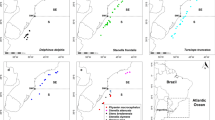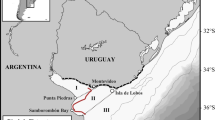Abstract
Stable isotope ratios of carbon (δ13C) and nitrogen (δ15N) in skin biopsy samples of four species in the Delphinidae family collected in 1993–2015 in the western North Pacific were investigated. Within the four species—common bottlenose, pantropical spotted, striped, and short-beaked common dolphins—δ13C and δ15N were highest in common bottlenose dolphins, and lowest in short-beaked common dolphins. Standard ellipse areas describing the likely range of the δ13C and δ15N, estimated using Bayesian inferences, indicated wider isotopic niche width in common bottlenose and pantropical spotted dolphins. Although spatial distribution patterns have been known to be similar among striped and short-beaked common dolphins, isotopic niche of the two species less overlapped. The stable isotope ratios were then analyzed in relation to space (longitude and latitude) and time (season) using generalized linear mixed models. The δ13C and δ15N values tended to be higher in lower longitudes for all four species, while δ15N tended to be lower in lower latitudes for common bottlenose and pantropical spotted dolphins, but lowest in higher latitudes for striped dolphins. These variations are considered to relate to north–south and coastal–offshore variations in nitrogen and carbon sources and nitrogen fixation in Kuroshio waters. This theory was further supported by analyzing stable isotope ratios in relation to distance to coast and sea surface temperature. Seasonal variations in δ13C and δ15N values were recognized for pantropical spotted and striped dolphins.






Similar content being viewed by others
References
Amano M (2015) Delphinus delphis Linnaeus, 1758. In: Odachi SD, Ishibashi Y, Iwasa MA, Fukui D, Saitoh T (eds) The wild mammals of Japan. Shoukadoh Books Sellers, Kyoto, pp 358–359
Betes D, Maechler M, Bolker B, Walker S (2015) Fitting linear mixed-effects models using lme4. J Stat Softw 67:1–48
Bisi TL, Dorneles PR, Lailson-Brito J, Lepoint G, Azevedo AdF, Flach L, Malm O, Das K (2013) Trophic relationships and habitat preferences of Delphinids from the southeastern Brazilian coast determined by carbon and nitrogen stable isotope composition. PLoS One 8:e82205. doi:10.1371/journal.pone.0082205
Browning NE, Dold C, I-Fan J, Worthy GAJ (2014) Isotope turnover rates and diet–tissue discrimination in skin of ex situ bottlenose dolphins (Tursiops truncatus). J Exp Biol 217:214–221
Buckland ST, Anderson DR, Burnham KP, Laake JL, Borchers DL, Thomas L (2001) Introduction to Distance Sampling. Oxford University Press, Oxford
Chou LS, Bright AM, Yeh SY (1995) Stomach contents of dolphins (Delphinus delphis and Lissodelphis borealis) from North Pacific Ocean. Zool Stud 34:206–210
DeNiro MJ, Epstein S (1978) Influence of diet on the distribution of carbon isotopes in animals. Geochim Cosmochim Acta 42:495–506
Fernández R, García-Tiscar S, Santos MB, López A, Martínez-Cedeira JA, Newton J, Pierce GJ (2011) Stable isotope analysis in two sympatric populations of bottlenose dolphins Tursiops truncatus: evidence of resource partitioning? Mar Biol 158:1043–1055
Forney KA, Ferguson MC, Becker EA, Fiedler PC, Redfern JV, Barlow J, Vilchis IL, Ballance LT (2012) Habitat-based spatial models of cetacean density in the eastern Pacific Ocean. Endang Species Res 16:113–133
Forney KA, Becker EA, Foley DG, Barlow J, Oleson EM (2015) Habitat-based models of cetacean density and distribution in the central North Pacific. Endang Species Res 27:1–20
Giménez J, Ramírez F, Almunia J, Forero MG, Stephanis R (2016) From the pool to the sea: Applicable isotope turnover rates and diet to skin discrimination factors for bottlenose dolphins (Tursiops truncatus). J Exp Mar Biol Ecol 475:54–61
Hobson KA, Gibbs HL, Gloutney ML (1997) Preservation of blood and tissue samples for stable-carbon and stable-nitrogen isotope analysis. Can J Zool 75:1720–1723
Jackson AL, Inger R, Parnell AC, Bearhop S (2011) Comparing isotopic niche widths among and within communities: SIBER—Stable Isotope Bayesian Ellipses in R. J Anim Ecol 80:595–602
Kanaji Y, Okazaki M, Kishiro T, Miyashita T (2015) Estimation of habitat suitability for the southern form of the short-finned pilot whale (Globicephala macrorhynchus) in the North Pacific. Fish Oceanogr 24:14–25
Kanaji Y, Okazaki M, Miyashita T (2016a) Spatial patterns of distribution, abundance, and species diversity of small odontocetes estimated using density surface modeling with line transect sampling. Deep-Sea Res Pt II. doi:10.1016/j.dsr2.2016.05.014
Kanaji Y, Okazaki M, Watanabe H, Miyashita T (2016b) Biogeography of small odontocetes in relation to wide-scale oceanographic structure in the North Pacific Ocean. Fish Oceanogr 25:119–132
Kasuya T (1999) Review of the biology and exploitation of striped dolphins in Japan. J Cetacean Res Manage 1:81–100
Kiszka J, Orémus M, Richard P, Poole MM, Ridoux V (2010) The use of stable isotope analyses from skin biopsy samples to assess trophic relationships of sympatric delphinids off Moorea (French Polynesia). J Exp Mar Biol Ecol 395:48–54
Kiszka J, Simon-Bouhet B, Martinez L, Pusineri C, Richard P, Ridoux V (2011) Ecological niche segregation within a community of sympatric dolphins around a tropical island. Mar Ecol Prog Ser 433:273–288
Kiszka J, Lesage V, Ridoux V (2014) Effect of ethanol preservation on stable carbon and nitrogen isotope values in cetacean epidermis: Implication for using archived biopsy samples. Mar Mamm Sci 30:788–795
Kodama T, Setou T, Masujima M, Okazaki M, Ichikawa T (2015) Intrusions of excess nitrate in the Kuroshio subsurface layer. Cont Shelf Res 110:191–200
Laws EA, Popp BN, Bidigare RR, Kennicutt MC, Macko SA (1995) Dependence of phytoplankton carbon isotopic composition on growth rate and [CO2]aq: Theoretical considerations and experimental results. Geochim Cosmochim Ac 59:1131–1138
Liu JY, Chou LS, Chen MH (2015) Investigation of trophic level and niche partitioning of 7 cetacean species by stable isotopes, and cadmium and arsenic tissue concentrations in the western Pacific Ocean. Mar Pollut Bull 93:270–277
Méndez-Fernandez P, Pierce GJ, Bustamante P, Chouvelon T, Ferreira M, González AF, López A, Read FL, Santos MB, Spitz J, Vingada JV, Caurant F (2013) Ecological niche segregation among five toothed whale species off the NW Iberian Peninsula using ecological tracers as multi-approach. Mar Biol 160:2825–2840
Minagawa M, Wada E (1984) Stepwise enrichment of 15N along food chains: further evidence and the relation between δ15N and animal age. Geochim Cosmochim Acta 48:1135–1140
Miyazaki N, Kasuya T, Nishiwaki M (1973) Food of Stenella coeruleoalba. Sci Rep Whales Res Inst 25:265–275
Murase H, Hakamada T, Matsuoka K, Nishiwaki S, Inagake D, Okazaki M, Tojo N, Kitakado T (2014) Distribution of sei whales (Balaenoptera borealis) in the subarctic–subtropical transition area of the western North Pacific in relation to oceanic fronts. Deep-Sea Res Pt II 107:22–28
Newsome SD, Clementz MT, Koch PL (2010) Using stable isotope biogeochemistry to study marine mammal ecology. Mar Mamm Sci 26:509–572
Ohizumi H, Yoshioka M, Mori K, Miyazaki N (1998) Stomach contents of common dolphins (Delphinus delphis) in the pelagic western North Pacific. Mar Mamm Sci 14:835–844
Ohizumi H, Kuramochi T, Kubodera T, Yoshioka M, Miyazaki M (2003) Feeding habits of Dall’s porpoise (Phocoenoides dalli) in the subarctic North Pacific and the Bering Sea basin and the impact of predation on mesopelagic micronekton. Deep-Sea Res Pt I 50:593–610
Pinela AM, Borrell A, Cardona L, Aguilar A (2010) Stable isotope analysis reveals habitat partitioning among marine mammals off the NW African coast and unique trophic niches for two globally threatened species. Mar Ecol Prog Ser 416:295–306
Quérouil S, Kiszka J, Cordeiro AR, Cascão I, Freitas L, Dinis A, Alves F, Santos RS, Bandarra NM (2013) Investigating stock structure and trophic relationships among island-associated dolphins in the oceanic waters of the North Atlantic using fatty acid and stable isotope analyses. Mar Biol 160:1325–1337
R Core Team (2016) R: a language and environment for statistical computing. R Foundation for Statistical Computing, Vienna. https://www.R-project.org/
Rau GH, Takahashi T, Des Marais DJ (1989) Latitudinal variations in plankton delta 13C: implications for CO2 and productivity in past oceans. Nature 341:516–518
Sackett WM, Eckelmann WR, Bender ML, Bé AWH (1965) Temperature dependence of carbon isotope composition in marine plankton and sediments. Science 148:235–237
Sasaki H, Murase H, Kiwada H, Matsuoka K, Mitani Y, Saitoh S (2013) Habitat differentiation between sei (Balaenoptera borealis) and Bryde’s whales (B. brydei) in the western North Pacific. Fish Oceanogr 22:496–508
Schoener TW (1974) Resource partitioning in ecological communities. Science 185:27–39
Takai N, Onaka S, Ikeda Y, Yatsu A, Kidokoro H, Sakamoto W (2000) Geographical variations in carbon and nitrogen stable isotope ratios in squid. J Mar Biol Ass UK 80:675–684
Tanaka H, Takasuka A, Aoki I, Ohshimo S (2008) Geographical variations in the trophic ecology of Japanese anchovy, Engraulis japonicus, inferred from carbon and nitrogen stable isotope ratios. Mar Biol 154:557–568
Tobayama T (1974) Studies on the feeding habits of the little toothed whales. Dissertation, University of Tokyo
Wada E, Hattori A (1991) Nitrogen in the sea: forms, abundances, and rate processes. CRC, Boca Raton
Walker WA, Jones LL (1994) Food habits of northern right whale dolphin, Pacific white-sided dolphin, and northern fur seal caught in the high seas driftnet fisheries of the North Pacific Ocean, 1990. Int N Pac Fish Comm Bull 53:285–295
Walker JL, Macko SA (1999) Dietary studies of marine mammals using stable carbon and nitrogen isotopic ratios of teeth. Mar Mamm Sci 15:314–334
Wang MC, Walker WA, Shao KT, Chou LS (2003) Feeding habits of the pantropical spotted dolphin, Stenella attenuata, off the eastern coast of Taiwan. Zool Stud 42:368–378
Zuur AF, Hilbe JM, Ieno EN (2013) A Beginner’s guide to GLM and GLMM with R. Highland Statistics, Newburgh
Acknowledgements
The authors sincerely thank H. Murase and S. Yonezaki for useful comments on earlier drafts of this manuscript. The collection of skin biopsy samples was supported by the International Fisheries Resources Survey Promotion Program from the Fisheries Agency of Japan. The study was financially supported by JSPS KAKENHI Grant Number 15H01610. This manuscript benefitted from the comments of anonymous reviewers. The authors declare that they have no conflict of interest. Research was conducted in accordance with “Guidelines for the Treatment of Marine Mammals in Field Research” by the Society for Marine Mammalogy.
Author information
Authors and Affiliations
Corresponding author
Additional information
Responsible Editor: Y. Cherel.
Reviewed by undisclosed experts.
Electronic supplementary material
Below is the link to the electronic supplementary material.
Rights and permissions
About this article
Cite this article
Kanaji, Y., Yoshida, H. & Okazaki, M. Spatiotemporal variations in habitat utilization patterns of four Delphinidae species in the western North Pacific, inferred from carbon and nitrogen stable isotope ratios. Mar Biol 164, 65 (2017). https://doi.org/10.1007/s00227-017-3107-z
Received:
Accepted:
Published:
DOI: https://doi.org/10.1007/s00227-017-3107-z




